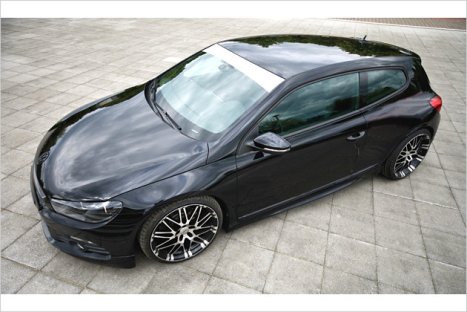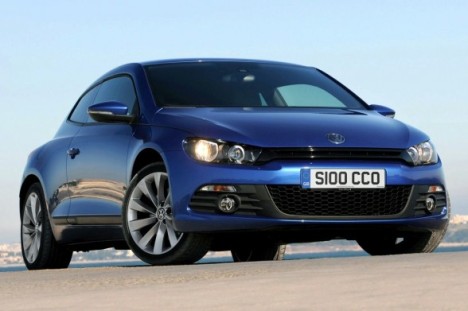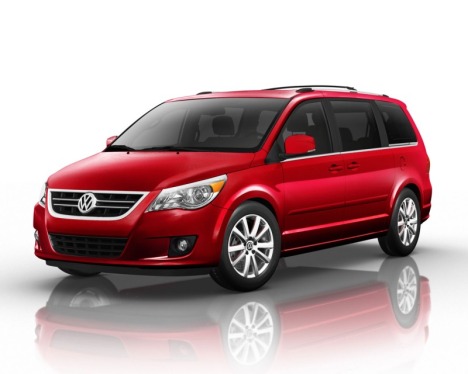
2010-Volkswagen-Golf
In the sixth generation of the world bestseller, Volkswagen Golf Variant is the fourth body version to be launched after the three- and five-door VW Golf and the latest VW Golf Plus. The Variant is one of the most successful models on the market, particularly in the company car market.
The extensive redesign of this Variant should ensure that the all-around talent further extends its position as a business estate car and as a first car for families as well. The base price of the new Volkswagen Golf Variant in Germany is € 18,500, which includes ESP, six airbags, daytime running lights, roof railing, electric windows all around, upshift indicator, electrically adjustable and heated outside mirrors, 1/3 to 2/3 split folding rear bench seat and backrest, central locking with RF remote, climate control, 16-inch wheels and up to 1,550 litres of cargo capacity.
The front end of the Volkswagen Golf Variant was completely redesigned. Its visual appearance follows today’s Volkswagen “Design DNA”. From now on, its appearance will be defined by clear horizontal lines and bold headlight styling. Key engines of the Golf three- and five-door models were also transferred to the Variant. In the interior, high-end instruments of the current Golf set the tone.
Body
The front end of the 4.53 meter long and 1.78 meter wide Volkswagen Golf Variant was completely redesigned. Visually, it now follows the styling of the current Volkswagen “design DNA”. Clear horizontal lines and bold styling of the headlights will now define its appearance. And so the bumper, radiator grille, engine bonnet and fenders and highlights were all transferred from the three- and five-door versions of the new Golf classic.
In contrast to the previous Volkswagen Golf Variant, the design is no longer characterised by a chrome radiator grille, rather by a black, horizontally styled grille and body-coloured bumpers. In its lower front section, the Variant also has an additional large air intake. Starting with the mid equipment version (Comfortline) chrome inserts are integrated in the radiator grille and lower air intake. In the case of the top Highline version, this also applies to the surrounds of the standard front fog lights with new static turning lights.
At the rear, the previous model’s independent design has been upgraded in the new generation by modified taillights and bumpers whose lower area is also fully painted in body colour. From now on, TDI and TSI versions can also be recognised by their tailpipes, which are no longer covered by the bumper. In addition, Volkswagen developed a new range of wheels for the Volkswagen Golf Variant.
Perfection in details
The new Volkswagen Golf Variant also preserves the car body’s excellent layout and high level of everyday utility. The development team focused on perfection in the details. Attaining the best possible acoustic properties on the new Golf was a top priority for Volkswagen. In this context, the body was equipped with new detailed solutions in a variety of areas. Highly effective acoustic damping is implemented in the front windscreen, which eliminates nearly all high-frequency noise in the three kHz range that is very typical in vehicles with diesel engines.
In addition, many secondary noises have been eliminated or reduced right at their source. In particular, this was achieved in all belt drives, the turbocharger and charge air distribution channels as well as in the heating and cooling blower. Quiet rolling tires and new engine bearings round out the noise reduction program. Independent of body-related modifications, noise comfort has been further improved by a new generation of turbo-diesels with common rail injection, as well as integration of TSI petrol engines that are known for their quiet operation.
PASSIVE SAFETY – HIGHEST LEVEL OF PROTECTION
The new VW Golf Variant is being offered with a seamless package of safety features as standard equipment. On the passive side, there is a further perfected safety body (including optimised pedestrian protection), six airbags and a patented head restraint system for driver and front passenger.
Front, side and head airbags
The driver and front passenger airbags (known as front airbags) and safety belt system together form a precisely coordinated front restraint system on the new Volkswagen Golf Variant. As before, the side airbags are still integrated in the backrests of the front seats. They protect the chest, abdomen and pelvis and have been optimally tuned to the car’s more rigid side structure. Integrating the side airbags in the backrests assures optimal airbag positioning in relation to the driver and front passenger. Furthermore, Volkswagen is introducing standard head airbags that help to prevent high biomechanical loads to the head. Specifically, these airbags cover an area along the side windows extending from the A pillar to the C pillar and from the roofliner to the door sill. This results in maximum protection at all seating positions regardless of body size. That is because protection over a large area prevents the head and extremities from swinging out and prevents objects from penetrating into the car’s interior. Since the head airbags remain inflated for a long time, they even retain much of their effectiveness in secondary collisions such as in the case of a rollover accident.
WOKS – head restraints help protect against whiplash
Accident-related hyperextensions of the cervical spine are known internationally as “whiplash syndrome”. Volkswagen counteracts these types of injuries by coordinating movements of the head and upper body into the seat backrests and head restraints as synchronously as possible in the event of a crash. This is called the “Whiplash Optimised Head Restraint System”, or WOKS for short. The latest generation of WOKS is now being implemented as standard equipment on the Golf.
In an effort to reduce injury risk, excellent protection is realised by defined deceleration of the upper body in the seat backrest, coordinated deceleration of the head in the head restraint, and balanced movements of the head and upper body. Crucial parameters here are the special contours of the head restraints and backrests as well as the hardness of the foam material that is used. The contoured shape of the head restraints is being patented by Volkswagen. In related studies, WOKS has demonstrated excellent protective potential with biomechanical values that are substantially better than those of many other active systems.
Interior
In the transition from the third to fourth generation of the Volkswagen Golf Variant, another tremendous leap has been made in quality. The high quality of the materials that are used is especially evident in the interior. This high level of value is a common thread running through the redesigned interior, especially when it comes to the car’s instruments. The look and feel of the materials, details such as brushed chrome accents and the round instruments and steering wheels taken directly from the VW Passat CC all leave the impression that one is actually sitting in a vehicle of the next higher market segment. And this is not just experienced in the two upgraded Golf equipment versions “Comfortline” and “Highline” but in the “Trendline” base version as well.
The interior ergonomics also reflect advanced development. All of the car’s functional components are even easier to operate. These include controls for the climate control system (Climatronic) initially introduced on the Passat CC. Sometimes it is the smallest of details that make the greatest impression. Consider the leather seats: a new more robust leather is being used in the new Volkswagen Golf Variant. Its improved surface properties make dye transfer, such as from jeans, passé even with very light-coloured leather. Or consider the redesigned steering column length and height adjuster; the lever was relocated from the centre of the steering column to the left side, making it ergonomically easier to reach.
Cockpit
The instrument panel of the Volkswagen Golf Variant was completely redesigned. This has resulted in a clear, well-organised geometry offering uncompromising ease of operation and a high level of timeless elegance. On initial contact, one is immediately impressed by the luxurious soft materials of the upper cockpit area and door trim that complement the design of the instruments.
The instruments of the Volkswagen Golf Variant now match instrument styling in the classic Golf three- and five-door models. Prominently displayed are the two round instruments with brushed chrome bezels, which are standard in the base vehicle; the tachometer is on the left, and the speedometer on the right. Also designed as a round instrument is the engine temperature gauge; it is integrated in the lower part of the tachometer. Its counterpart is the fuel gauge integrated in the speedometer. Gauge scale markings are backlit in white (regardless of whether the headlights are on or off); while turn signal indicators are in red. Also designed in white now are the graphics of the multi-function display (MFD) – located between the tachometer and speedometer – which is always standard equipment. An upshift indicator was integrated in the MFD, which depends on the engine option.
Another redesigned component is the light switch. On the “Comfortline” and “Highline” equipment versions, the switch’s handhold is in metal. Like the main instruments, air vents near the instrument cluster also have brushed chrome bezels. There is one vent at each end of the instrument panel for driver and passenger, and two in the centre console. In addition, a vent for the side windows is integrated in each of the A-pillar trim panels. Complementing the chrome bezels, the upper and lower sections of instruments are separated by dark silver accents (“Titan”) on the “Trendline” base version. In the middle “Comfortline” equipment version the accents are glossy black (“Black Pyramid”), and in the top “Highline” version they are light “Brushed Chrome”.
Centre console
All of the controls arranged on the centre console are readily and equally accessible to driver and front passenger. Right at the top is the hazard flasher switch, optimally located between the air vents. On the level below this, there is the audio or radio-navigation system. The third level of controls contains interfaces to the heating and ventilation or climate control system. Another set of switches is located directly in front of the gearshift lever for activating or deactivating systems such as ESP and “Park Assist”.
If the Volkswagen Golf Variant is ordered with an automatic climate control system (Climatronic), a new set of controls is provided. There are two control knobs, one on the left and one on the right, for selecting temperatures in 1 degree increments separately for driver and passenger sides. They are also used to activate seat heating. Naturally, the temperature for the two sides can be controlled jointly too. The set temperature is displayed outside of the control knob, in its bezel, and if a RCD 310, RCD 510, RNS 310 or RNS 510 radio or radio-navigation system is installed, the temperature is also shown in that unit’s display. The main operating modes of the Climatronic (“Auto”, completely “Off”, “Dual”, “AC”) and blower levels are set in the area between the two control knobs. Located in the upper area are controls for ventilation modes, rear window heating and recirculation functions.
Further down the centre console, at the height of the handbrake lever, are the familiar storage compartment and an AUX-IN port (standard with RCD 310 and higher) that can be used to connect devices such as an MP3 player. The optional MEDIA-IN port can also be integrated in the storage compartment of the equipment line dependent centre armrest. This USB port is used to interface to a wide variety of memory sources for the audio system. For example, an iPod – including its special control functions – can also be integrated in the system as a music source with a suitable cable.
Seats
Volkswagen is offering the new Volkswagen Golf Variant in four different seat configurations, depending on the equipment line. The “Trendline” base version already has excellent contoured seats in the “Roxy” fabric style. These seats can be ordered in “Titan Black” or “Latte Macchiato” colour. The comfort seats of the Volkswagen Golf Variant Comfortline are now designed to be even more ergonomic. The cross-stitched fabric of the seat and backrest surfaces creates a clear visual contrast to exterior surfaces. This fabric pattern is called “Scout / Merlin”, and it too can be ordered in “Titan Black” or “Latte Macchiato” colour.
The sport seats of the Volkswagen Golf Variant Highline are especially refined. They are upholstered in Alcantara (centre seat panels) and fabric (“Dropmag” style). Colours of the “Highline” seats: “Titan Black” or “Corn Silk” plus “Titan Black”. In addition, Volkswagen is offering a seat system on the Golf Variant Highline that is upholstered in high-end “Vienna” leather. The colours “Titan Black” and “Corn Silk” are also offered here.
The latest generation of the bestselling five-seater offers exceptionally spacious conditions. In front, the maximum interior height is 1,032 millimetres (seat in lowest position). The rear seating area offers a maximum interior height of 986 millimetres, depending on the version. Leg room in the so-called extended position of the driver’s seat is 45 millimetres. Also contributing to the car’s good comfort and ergonomic properties is the comfortable seat height of 274 millimetres in front and 321 millimetres in the rear. The interior width of the Volkswagen is 1,446 millimetres in front and 1,437 millimetres in the rear.
Cargo area
The new Volkswagen Golf Variant is a compact space wonder. When the cargo partition net is installed and cargo is loaded up to the height of the top of the rear bench seatback, the Variant provides up to 745 litres of load volume; up to the load sill at window height it is a maximum of 560 litres. When the rear bench seat is folded down and the interior space is fully utilised, up to 1,550 litres of cargo volume can be stowed in the VW Golf Variant (all data includes spare wheel recess).
When the rear bench is folded, the continuous flat cargo area of the new Volkswagen Golf Variant up to the driver’s backrest measures 1.70 meters, and when the front passenger seat is folded down this results in a 2.72 meters long pass-through surface. Bins offer storage space under the cargo floor and in the side panelling. Even when the standard factory-installed asymmetrical split bench is not lowered, a respectable 1.07 meters of cargo length is still available. Maximum width: 1.29 meters. Interior width between wheel wells is 1.01 meter.
Operating the factory-installed asymmetrically split rear bench seat is exceptionally easy. Release buttons next to the outer head restraints disengage the backrests from their anchorages so that they can be folded forward. A clever detail is a red indicator, visible from the front seats too, that warns if one of the two rear backrests is not fully engaged when lifting the seatback up again. As a standard feature on the Volkswagen Golf Variant Comfortline and a special option on other equipment lines, the front passenger backrest can also be folded forward, resulting in a single continuous loading surface.
Interior variability is also enhanced by the centre armrest in the rear seating area, which is standard equipment starting at the Comfortline level. When folded down, it creates an especially large pass-through to the cargo area, making it easy to stow long and bulky sports equipment such as paddles or skis.
Load safety: Preventive practical solutions
To prevent cargo from shifting into the passenger area during a collision or hard braking, the Volkswagen Golf Variant can be equipped with a cargo partition net. Normally, it is installed behind the rear bench seat. However, when the rear backrest is folded forward, the net can be anchored near the front backrests.
Providing for additional cargo safety are four tie-down eyes located on the right and left side panels in the cargo area, and at the front of the cargo area. When they are not in use, they can be folded away without leaving any corners or edges protruding. Another extremely practical feature for securing individual objects in the cargo section is the variable cargo floor. A handle is used to set it in place, and it latches securely in the notches provided for it. Smaller thin objects will also fit in the storage bin beneath the variable cargo floor.
Just as practical: The special bag hooks that fold out from the side panelling of the cargo area. They are standard equipment and prevent shopping bags from spilling their contents into the cargo area while driving. The first aid kit and hazard triangle are at an easy-to-reach location behind a cover in the left side panel of the cargo area.
Panoramic sunroof creates a bright ambiance
As a special equipment option – and a standard feature on the Golf Variant Highline – Volkswagen is offering a newly designed panoramic sunroof. With a length of 1.36 meters and width of 0.87 metres, its transparent surface spans a large section of the interior, creating a pleasant, light-filled ambiance. The roof consists of two halves; the front section can be raised or fully opened. To preserve full interior height, the section that opens is driven out above the closed section of roof. An electrically-powered sunshade offers protection from intense sunlight.
Engines and transmissions
At the car’s European market launch, Volkswagen will be offering the new Volkswagen Golf Variant with four petrol and two diesel engine options. Their power ranges from 59 kW / 80 PS to 118 kW / 160 PS. Four of the six engines are supercharged and/or turbocharged. As in the classic Golf, the latest generation of common rail turbo-diesels (TDI) will be used for the first time in the Volkswagen Golf Variant too. They replace the previously offered pump-nozzle direct injection engines and play a significant role in the new Volkswagen Golf Variant’s pioneering acoustic properties.
The petrol and diesel engines across all power levels consume less fuel than similarly powered engines of the previous model. Fuel savings and related lower emissions are huge in some cases.
PETROL ENGINES – MORE FUEL EFFICIENT THAN EVER
The range of petrol engines in the launch phase spans four versions with 59 kW / 80 PS, 75 kW / 102 PS, 90 kW / 122 PS and 118 kW / 160 PS. Starting at 90 kW / 122 PS, TSI engines with supercharger and/or turbocharger are used. Clearly, the petrol engines are pioneers in fuel efficiency too. The optimised 80-PS entry-level engine consumes just 6.4 litres Super per hundred kilometres (149 g/km CO2). Once again, the TSI engines are taking the stage as prime examples of efficiency: the new Golf 1.4 TSI with 122 PS consumes just 6.0 litres Super (139 g/km CO2). Even the new 160-PS top version of the 1.4 TSI attains a top value at 6.1 litres (DSG version).
1.4 with 59 kW / 80 PS
The entry into the world of VW Golf Variant engines is marked again by the 1.4-litre engine (1,390 cm3), which has proven itself a million times over and outputs 59 kW / 80 PS power at 5,000 rpm. The petrol engine attains its maximum torque of 132 Newton-meter at 3,800 rpm. A version of this economical bestselling engine with wide-ranging technical modifications is being used in the new Volkswagen Golf Variant; it shines with a combined fuel consumption of just 6.4 litres per hundred kilometres (149 g/km CO2).
With this engine, the Volkswagen Golf Variant attains a top speed of 173 km/h. Shifted by a five-speed gearbox, it takes 14.9 seconds for the four cylinder to accelerate the Variant to 100 km/h. The first service inspection – and this applies to all new Volkswagen Golf Variant versions – is not due until after three years or 60,000 kilometres. The 1.4-litre engine is exclusively available in conjunction with the Trendline equipment line.
1.6 with 75 kW / 102 PS
Like the 1.4 litre petrol engine, the modified 1.6 litre engine (1,595 cm3) with 75 kW / 102 PS (5,600 rpm) satisfies the strict Euro-5 emissions standard. The four-cylinder develops a maximum torque of 148 Newton-meters at 3,800 rpm. With this engine, the new Volkswagen Golf Variant handles the sprint to 100 km/h in 12.2 seconds; its top speed is 189 km/h. On average, the petrol engine consumes 7.2 litres of fuel per 100 kilometres (168 g/km CO2). Like the 1.4, the Volkswagen Golf Variant 1.6 is also shifted by a five-speed transmission as standard equipment. The Volkswagen Golf Variant 1.6 is available in the Trendline and Comfortline equipment lines.
1.4 TSI with 90 kW / 122 PS
The turbocharged TSI with 90 kW / 122 PS is one of the most advanced petrol engines in the world. There is hardly another petrol engine that can match its impressive power curve with such fuel efficiency. In the new Volkswagen Golf Variant, the four-cylinder direct injection engine requires just 6.3 litres of fuel per 100 kilometres (146 g/km CO2). A six-speed gearbox is standard with this engine. The Volkswagen Golf Variant 1.4 TSI with 122-PS is even more fuel efficient when shifted via the optional 7-speed DSG; this configuration yields a combined fuel consumption of 6.0 litres (139 g/km CO2).
The car’s fuel efficiency contrasts with its excellent driving performance. The Volkswagen Golf Variant 1.4 TSI at this power level is moving at 100 km/h after just 9.9 seconds, shifted by a manual gearbox or DSG. Its top speed in both cases is 200 km/h. Like all engines of the new Volkswagen Golf Variant, this TSI also fulfils the Euro-5 standard.
This highly praised and award-winning engine develops its peak power of 122 PS at 5,000 rpm. The engine’s maximum torque of 200 Newton-meters is available over a broad speed range extending from a low 1,500 to 4,000 rpm. Even at 1,250 rpm – barely above idling speed – the engine can output 80 percent of its maximum torque.
1.4 TSI with 118 kW / 160 PS
As the most powerful petrol engine in the new Volkswagen Golf Variant, Volkswagen is implementing a four cylinder that is both turbo- and supercharged and has a power of 118 kW / 160 PS (at 5,800 rpm). Of special interest here is the engine’s specific power: the 1.4 litre engine attains 84.3 kW or 114.3 PS per litre displacement. Its maximum torque of 240 Newton-meter is available between 1,500 and 4,500 rpm. Like the 122-PS TSI, this engine is also exceptionally fuel-efficient. The 160-PS TSI attains a top value in savings at 6.4 litres per 100 kilometres (equivalent to 149 g/km CO2). When the 160-PS TSI is paired with 7-speed DSG, fuel consumption is even reduced to 6.1 litre (143 g/km CO2).
The driving performance data of the Volkswagen Golf Variant 1.4 TSI with 160 PS is also impressive: in both transmission versions the Volkswagen is moving at 100 km/h after just 8.4 seconds; its top speed is 220 km/h. The top model among the petrol engines can be ordered on the Comfortline and Highline equipment lines.
DIESEL ENGINES – MORE EFFICIENT AND QUIETER
As in the classic Golf, Volkswagen is now converting all TDI engines over to 16-valve common rail engines with 1.6 and 2.0 litre displacement in the Variant version of the bestseller as well. Internationally, plans call for power levels of 66 kW / 90 PS, 77 KW / 105 PS and 103 kW / 140 PS. Right at the Variant’s market launch, Volkswagen is offering the versions with 105 PS and 140 PS. Always aboard: a diesel particulate filter (DPF). Besides their economy and agility, the new TDI engines also distinguish themselves by their low-noise properties. Two balancing shafts on the 140-PS version put an end to undesirable vibrations too. In addition, a new engine bearing design ensures that the engines are better isolated from the car body. Volkswagen will be offering the 6-speed DSG as an option with both TDIs.
1.6 TDI with 77 kW / 105 PS
Technically, the 1,598 cm3 TDI sets the highest standard in its market segment. Via the common rail system, the diesel fuel is injected directly into the combustion chamber at a pressure of 1,600 bar. Special piezo actuators control the multiple injections and fuel quantities with maximum precision.
To reduce internal engine friction as much as possible, the crankshaft, valve and oil pump drives were optimised. A square stroke/bore ratio minimises friction losses at the cylinder liners. Furthermore, losses in the flow of oil and coolant were reduced, and frictional losses were reduced in air induction and charge air flows. This has resulted in a TDI line-up that offers uncompromisingly low fuel consumption and emission values without lacking even the slightest in comfort or dynamic performance.
The 77 kW / 105 PS (at 4,400 rpm) TDI accelerates the new Volkswagen Golf Variant to 100 km/h in 11.9 seconds – with either a manual 5-speed gearbox or optional 7-speed DSG; in both cases its top speed is 190 km/h. Its exceptionally high maximum torque of 250 Newton-meters lies between 1,500 and 2,500 rpm, which promotes a restrained, economical style of driving. Combined fuel consumption for the new engine aboard the VW Golf Variant TDI is an excellent low 4.5 litres of diesel per 100 kilometres (119 g/km CO2). With a 7-speed DSG, these values are 4.8 litres and 125 g/km CO2. The 105-PS TDI can be ordered on any of the three equipment lines. And that is not all. It is also being offered with the optional BlueMotionTechnology package. In this case, the Volkswagen Golf Variant’s low combined fuel consumption drops from 4.5 to 4.2 litres fuel (109 g/km CO2)
2.0 TDI with 103 kW / 140 PS
The 103 kW / 140 PS TDI is also exceptionally fuel efficient (may be ordered with Comfortline or Highline). Driven by this engine, the Volkswagen Golf Variant only needs 5.0 litres of diesel to cover a hundred kilometres (132 g/km CO2). If the Variant is ordered with a 6-speed DSG at this power level, combined fuel consumption is 5.5 litres (equivalent to 144 g/km CO2). In both cases, this contrasts with a top speed of 210 km/h and 9.7 seconds acceleration time for the classic sprint to 100 km/h.
In addition, the TDI shines at practically every engine speed with categorically high torque; it already delivers its maximum torque of 320 Newton-meter starting at 1,750 rpm and holds it constant up to 2,500 rpm.
Fuel induction in the large direct injection turbo-diesel engine is handled by the latest generation common rail system. Up to 1,800 bar injection pressure and special eight-hole injection nozzles deliver especially fine atomisation of the diesel fuel. The eight-hole injection nozzles are controlled by the latest generation of piezo in-line injectors. Electrically-controlled piezo crystals, assisted by a hydraulic element, inject fuel in fractions of a second. Compared to conventional solenoid valves, piezo technology enables more flexible injection processes with smaller and more precisely metered fuel volumes. The benefit: a very quiet and pleasantly smooth running engine, exceptional responsiveness and low fuel consumption and emissions. Also having a positive effect on acoustics is the completely maintenance-free toothed belt drive of the camshaft. Thanks to the conversion to common rail technology and numerous other acoustic measures such as a noise-damping film in the windscreen, both VW Golf Variant TDI versions are among the quietest diesel models in their class.
DSG: 6- And 7-speed DIRECT SHIFT GEARBOXES
All TDI and TSI versions of the new Volkswagen Golf Variant are available with the optional Direct Shift Gearbox (DSG). Depending on the torque of the engine, the Golf either gets a 6-speed or 7-speed DSG. The extremely efficient and agile DSG is completely supplanting the classic torque-converter automatic in the Golf.
Both DSG versions are characterised by maximum economy and dynamic shifting unlike that of any previous transmission. Besides their different numbers of forward gears, the two DSGs differ technically in their clutch type. While two dry clutches are used in the 7-speed DSG, the dual clutch of the 6-speed DSG runs wet in an oil bath. True of both transmissions: even the most experienced professional drivers cannot even approach the shifting speed of either DSG version. Another fact: more than any other automatic, the dual clutch transmissions have the potential to reduce fuel consumption and thereby emissions.
The two DSG variants are each specialists in their applications. While the 6-speed DSG shines when paired with torque-strong engines (up to 350 Newton-meter), the 7-speed DSG is especially effective in combination with smaller engines (up to 250 Newton-meter).
Features
At its market launch, the successful Variant (more than 95,000 new vehicle registrations in 2008) will be offered in the three equipment versions Trendline, Comfortline and Highline. The latter replaces the previous Sportline version as the top equipment line. Always standard in all versions are six airbags, the ESP electronic stabilisation program with counter steering assist and trailer stabilisation and climate control. Moreover, there are specific details that distinguish each version. The Volkswagen Golf Variant Comfortline, for example, has a standard folding backrest on the front passenger seat that folds completely forward to provide space for especially long objects. The Volkswagen Golf Variant Highline has details such as a panoramic sunroof and Alcantara sport seats that make up its special character.
Volkswagen Golf Variant Trendline
The lowest featured version even offers a considerable array of standard features. In Germany, the new model is distinguished from the previous model by additional standard features such as the multi-function display (trip computer), visible tailpipes (beginning at 105 PS), “Titan” decorative accents, daytime running lights integrated in the headlights, dual-tone horn, extended ESP that includes the comfort braking assistant, door handles and door mirror housings painted in body colour and the semi-automatic “Climatic” climate control system. Other standard features include electric window lifts (front and rear), RF remote central locking, a removable cargo area liner, cargo area lighting, various storage compartments including one in the roofliner, electrically adjustable and heated door mirrors and roof rails. The VW Golf Variant Trendline is delivered with size 205/55 R16 tyres as standard equipment.
Volkswagen Golf Variant Comfortline
The differentiating features are even more distinctive on the new Golf Comfortline. Above and beyond “Trendline” items, the additional features that now underscore the high-end character of this version include new 16-inch steel wheels with 5-spoke covers in alloy look, comfort seats and folding front passenger seat,, a chrome light switch, new decorative inserts (“Black Pyramid”), chrome trim strips on the side windows, chrome frames around the horizontal radiator louvers, parking distance control (Park Pilot) front and rear, carpet floor mats, leather for the new three-spoke steering wheel, leather gearshift knob and handbrake lever, new velour upholstery (“Scout”) and the RCD 210 radio-CD system with MP3 function.
Volkswagen Golf Variant Highline
The “Highline” equipment line was discontinued on the previous fifth generation of the Golf, in which the Golf Sportline assumed the role of the top model. Exterior features distinguishing the new “Highline” version from the Volkswagen Golf Variant Trendline and Comfortline include: new 17-inch alloy wheels (“Porto”) with size 225 tyres, chrome louvres on the radiator grille and air intake screen also in chrome, front fog lights with static curve lights, headlight washing system, heated windscreen washer nozzles and silver-anodised roof railings.
Inside, the Volkswagen Golf Variant Highline makes its appearance with features such as the extended multi-function “Plus” display unit, sport seats with centre panels in Alcantara (“Dropmag” style), decorative inserts in “Brushed Chrome”, height adjustment for the front passenger seat, chrome bezels around the light switch, mirror adjustment switches and control keys for the window lifts, heated seats and climate control (Climatronic).
Moreover, there are numerous other features, some of them new, that are available as options on all versions of the new Volkswagen Golf Variant.
Radio and Radio-Navigation systems
Volkswagen is offering the new Volkswagen Golf Variant with three radio systems and two radio-navigation systems of the 210, 310 and 510 series. Hands-free telephone units can be added to any of the infotainment systems. Always standard equipment on cars with one of the radio and radio-navigation systems, starting with the 310 series, is an AUX-IN port for an external MP3 player. 310 and 510 series units also have an optional USB port (MEDIA-IN) and CD changer (for the navigation systems).
All radio and radio-navigation systems have a MP3-capable CD player. The radio systems carry the designations RCD 210, RCD 310 and RCD 510; their counterparts with an additional navigation system are the RNS 310 and RNS 510. A rearview camera integrated in the tailgate can also be interfaced to the RNS 310, RCD 510 and RNS 510 units. The RNS 510 utilises a 30 GB hard drive for navigation and entertainment.
The latest infotainment unit in the Volkswagen program is the RNS 310 radio-navigation system. Like the larger RNS 510 radio-navigation system and the RCD 510 radio system, it is also equipped with a user-friendly touch-screen. This colour screen measures five inches (400 x 240 pixels). Furthermore, the RNS is equipped with a SD card slot and a dual tuner. The SD card can be used to save navigational data (data copied from the navigation CD) as well as MP3 files for music reproduction.
Park Assist
The “Park Assist” parking assistance system being offered for the first time in the Volkswagen Golf Variant is an example of high-end technology. The system is capable of nearly automatic reverse parking in parallel parking spaces that are just 1.1 meter longer than the vehicle. The driver just needs to operate the gas pedal, brake and clutch; meanwhile, the Volkswagen Golf Variant steers into the pre-measured space, guided by sensors. Whenever the steering process is interrupted by manual steering, “Park Assist” is deactivated. The intuitively operated system is started by pressing a button located right in front of the gearshift knob.
While driving down the road at speeds up to 30 km/h and at a distance of 0.5 to 1.5 meters from other parked cars, ultrasonic sensors detect all parking spaces aligned with the roadway on either the left or right (depending on the turn signal direction that is set), and a control module computes the ideal parking path. “Park Assist” communicates the starting position to the driver via the multi-function display. Then the driver shifts into reverse gear.
Now appearing on the display is the message “Steering control active! Watch your surroundings!” The driver only needs to accelerate, apply the clutch and perform braking during the rest of the parking process; the steering is handled by the Volkswagen Golf Variant. As soon as the “Park Pilot” switches to a continuous signal at the rear, this indicates that the optimal distance to the next vehicle has been reached (approx. 20 centimetres). If the speed is excessive and/or the driver makes any sort of steering wheel movement, “Park Assist” is instantaneously deactivated. Generally, the entire parking process after shifting to reverse gear takes only 15 seconds.
Rearview camera
The new generation of the Volkswagen Golf Variant will also be available for the first time with a rearview camera, or what is known as “Rear Assist”. As soon as the reverse gear is engaged, the camera integrated in the tailgate monitors the space behind the Volkswagen Golf Variant.
The system can be ordered in conjunction with the new touch-screen radio and radio-navigation systems RNS 310, RCD 510 and RNS 510. Camera images are transmitted to the touch-screen as real-time images. The path steered is also shown by orientation lines on the screen. Even the smallest of obstacles are easy to recognise with the rearview camera, and the tightest of parking spaces can be mastered with millimetre accuracy. “Rear Assist” also simplifies the process of hooking up trailers. The camera itself has a wide-angle lens. Horizontally, it acquires objects over an angular range of 130 degrees, and vertically over a range of 100 degrees.
Volkswagen Golf Variant Exclusive
Effective immediately, Volkswagen Individual is launching the new “Volkswagen Exclusive” product brand. In the future, it will market very exclusive models and special equipment for a wide variety of model series under this label. The first model to be offered in an Exclusive version will be the new Volkswagen Golf Variant, which will cross over from an everyday all-purpose vehicle to a lifestyle estate car. Elegant Highline features form the basis for the Volkswagen Golf Variant Exclusive. And here are the Exclusive ingredients:
The exterior will launch with such features as a sport chassis (15 millimetre lower ride height), 17-inch alloy wheels (“Sienna” in “Titan Silver”) and new Volkswagen Exclusive logos. Contact to the road will be provided by sporty, wide profile 225/45 tyres. Making the transition to the interior are door tread plates that are also upgraded with the new logo.
The interior impresses with an extremely extensive array of special features. Along with Highline equipment such as automatic climate control (“Climatronic”), a panoramic sunroof and the “RCD 210” radio-CD system, the following additional features from the new Volkswagen Exclusive program are also offered: electric lumbar support, storage drawers under the front seats, leather steering wheel, leather gearshift knob and handbrake lever, carpet floor mats in front and rear with coloured piping and door trim in leather look. The sport seats in the leather combination “Nappa / Vienna” (heated seats in front), which are also standard, may be ordered in either the “Sioux / Titan Black” or “Cinnamon / Titan Black” colour combination. All leather interfaces are also provided with decorative colour seams. Never before has a Volkswagen Golf Variant made such an elegant appearance in the showroom.
Filed under: Volkswagen | 1 Comment »
 Volkswagen New Beetle: -Return of a Legend
Volkswagen New Beetle: -Return of a Legend












 After launching the Jettas, the Passats and the Touaregs; the first VW hatchback will hit the Indian roads. The Polo is a premium hatchback that will be manufactured from the recently inaugurated Volkswagen plant in Chakan.
After launching the Jettas, the Passats and the Touaregs; the first VW hatchback will hit the Indian roads. The Polo is a premium hatchback that will be manufactured from the recently inaugurated Volkswagen plant in Chakan. By now all the tiger/iguana jokes have been told at the Volkswagen Tiguan’s expense, but it’s hardly anyone’s fault but VW’s for naming their compact SUV after an improbable feline-reptile crossbreed.Debuting as a 2009 model, the Tiguan is a Volkswagen’s punchline to the compact SUV question.
By now all the tiger/iguana jokes have been told at the Volkswagen Tiguan’s expense, but it’s hardly anyone’s fault but VW’s for naming their compact SUV after an improbable feline-reptile crossbreed.Debuting as a 2009 model, the Tiguan is a Volkswagen’s punchline to the compact SUV question. Volkswagen says it will begin manufacturing a new compact sedan at its plant in Mexico, with a launch date of
Volkswagen says it will begin manufacturing a new compact sedan at its plant in Mexico, with a launch date of



 The Volkswagen Routan is a shared project with Chrysler, if shared means take my van and add your logos and some new sheet metal.
The Volkswagen Routan is a shared project with Chrysler, if shared means take my van and add your logos and some new sheet metal. German auto maker Volkswagen is planning to introduce its first all-electric car in 2013.
German auto maker Volkswagen is planning to introduce its first all-electric car in 2013.